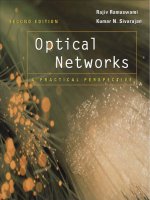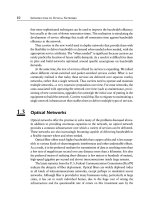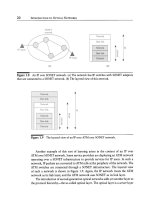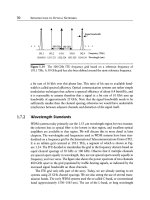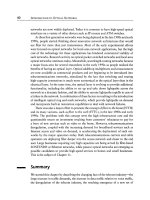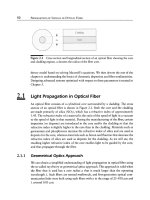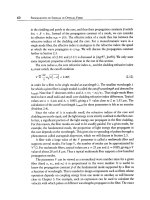Optical Networks: A Practical Perspective - Part 86 pdf
Bạn đang xem bản rút gọn của tài liệu. Xem và tải ngay bản đầy đủ của tài liệu tại đây (476.19 KB, 13 trang )
820
INDEX
polarization-mode dispersion (PMD) (continued)
origin, 320
outage, 320
outage probability, 320
penalty causes, 320
power penalty, 354-355
RZ modulation and, 322
second-order, 322
for typical fiber, 320
See also
dispersion
policing, 513-514
population inversion,
153
higher, 156
SOAs and, 162-163
for thermal equilibrium, 156
positive dispersion fibers, 95-98
postal, telephone, and telegraph (PTT)
companies, 4
power amplifiers, 290, 291
power penalty, 284-287
allocation, 287
budgeting, 286
extinction ratio, 288
four-wave mixing (FWM), 330
impairments resulting in, 286
interchannel crosstalk, 301,303
intrachannel crosstalk, 300, 301
lumped amplifiers,
295
optimized threshold setting and, 285
power transfer function,
745
dielectric slab, 745-746
dielectric thin-film filter, 748, 749
of Fabry-Perot filter, 131,132
multiple dielectric slabs, 748
power transients, 296
PPS testbeds, 650-657
All-Optical Network (AON)
consortium, 655
BT Labs, 654
Contention Resolution by Delay Lines
(CORD) testbed, 656-657
focus, 650
FRONTIERNET switch, 652-654
KEOPS (Keys to Optical Packet Switching),
650-652
key features, 651
NTT optical ATM switches, 652-654
Princeton University, 654-655
See also
photonic packet-switched (PPS)
networks
practical networks, 25
prechirping, 343
Princeton University testbed,
654-655
private line services, 7
private network-network interface (PNNI)
signaling protocol, 581
private user-network interfaces, 382
probability density functions
Gaussian distribution, 752-753
Maxwellian, 753
for photocurrent,
259
random variables, 751-752
probability mass function, 753-754
propagation
by total internal reflection, 52
calculation methods, 130-131
delay, 647
error, 247
intensity dependence, 736
light,
50-64
in nonlinear medium, 81-83
pulse, 731-740
soliton, 336, 337
wave, 743-747
propagation constant, 59, 84, 110
at angular frequency, 84
normalized, 61
protection, 537, 538
1+ 1,544-546
1:1,546
bandwidth-efficient,
679
capacity, 584
client layer,
563
dedicated, 540
implementation, 537
in IP networks, 558-559
mechanisms in different layers, 582
mesh,
576-581
nonrevertive, 540
optical layer,
560-582
point-to-point links,
544-546
protect paths, 539
revertive, 540
service classes based on,
566-567
shared, 540, 584
in SONET/SDH,
542-558
subnetwork connection (SNCP), 544, 547
INDEX 821
working paths, 539
See also
failures
protection switching, 199, 537
automatic (APS), 541-542
bidirectional, 540, 541,542
unidirectional, 540, 541-542
protect paths,
539
public user-network interfaces, 382
pulse-broadening
chromatic dispersion, 70, 71
SPM and, 84, 86
pulse compression effect, 72, 73
pulse propagation, 731-740
chirped Gaussian, 734-735
nonlinear effects on, 735-738
soliton, 738-739
pulses
chirped Gaussian, 69-74,
104, 356, 734-735
chirp RZ, 100
envelope, 739
framing, 620
group velocity, 732, 733
narrow spectral width, 733
phase velocity, 732
soliton, 98, 100, 336
SPM effect on, 737
unchirped, 312, 313
pulse walk-off phenomenon, 327
pulse width
half-width, 311
optimum, 312
root-mean square (rms)
width, 311
quality-of-service (QoS), 8, 9
ATM, 386-387
guarantees, 387
IP, 392
quantum limit, 253
queuing delay, 647
Raman amplifiers, 159-161
crosstalk, 161
distributed, 160, 295
drawbacks, 160-161
EDFAs vs., 159
fiber, 66
illustrated, 160
noise sources, 160
pump sources for, 190-191
spontaneous emission noise, 161
See also
optical amplifiers
Raman gain coefficient, 327
random processes, 754-756
autocorrelation, 754
autocovariance, 754
first-order density function, 754
first-order probability distribution
function, 754
Gaussian, 756
Poisson, 755-756
power spectral density,
755
second-order density function, 754
second-order distribution function, 754
uses, 7
variance of, 755
wide-sense stationary,
754
random variables, 751-752
ranging,
604
rate-preserving overhead, 518
Rayleigh scattering, 65, 67
coefficient, 67
loss due to, 67
ray theory.
See
geometrical optics approach
receiver noise statistics, 757-762
receivers, 288-289
APD, 260, 261,277
coherent, 263-265
decision threshold, 285
direct detection, 253-254,
265,273
heterodyne, 264
homodyne, 264
ideal, 252-253
parameters, 288
receiver sensitivity, 260, 273, 288-289
of APD receiver, 261,277
coherent receiver, 265
as function of bit rate, 261
obtaining, 260
overload, 288,289
of
pin
diode, 261
plotting, 277
typical, 289
reciprocal devices,
112
recirculation buffering, 639-641
contention resolution and, 640
822
INDEX
recirculation buffering
(continued)
low differential loss, 641
See also
buffering
reconfigurable OADMs, 417-419, 432
fully tunable with parallel architecture,
417, 418
fully tunable with serial architecture, 417, 418
illustrated, 418
partially tunable with parallel architecture,
417, 418
partially tunable with serial architecture,
417, 418
types of, 417
See also
optical add/drop multiplexers
(OADMs)
redundancy, 267
increasing, 271
Reed-Solomon codes, 271-272
Reed-Solomon codes, 270-272
coding gain, 270
large burst correction with, 271-272
principle of operation, 270-272
redundancy, 271
restriction, 270
reflection coefficient, 744, 745
reflection gratings,
120
blazed, 121,122, 227
illustrated, 119
refractive index, 50
intensity-dependent, 85, 333, 736
LEAF, 95
linear, 736
near beam center, 55
nonlinear, 92
profile, 75, 76
TE mode, 144, 145
TM mode, 144, 145
variation of, 75
regeneration
optoelectronic, 218
with reshaping and retiming (3R), 217,
221-223
regenerators, 35, 151
regional Bell operation companies (RBOCs),
3-4
relative intensity noise (RIN), 182, 287
remote nodes (RNs), 593
illustrated, 594
processes, 593
repetition code, 269-270
resonant wavelengths, 131
resource reservation protocol (RSVP),
394, 581
restoration,
537
time requirements, 538-539
time scale, 537
return-to-zero (RZ) modulation, 240-242
bit rate and, 312
chirped, 343
chromatic dispersion limits, 311-314
peak transmit power, 241
PMD and, 322
uses, 242
variations, 240
See also
signal formats
reuse factor, 467
determining, 467
for different RWA algorithms, 474
improvement, 468
number of nodes vs., 469, 470
number of wavelengths vs., 468
reverse-biased pn-junction, 195, 196
revertive protection,
540
ring networks, 431,432
fixed-wavelength conversion, 479
full wavelength conversion, 479
with N nodes, 482
optical-layer equipment, 441
wavelength assignment in, 478
wavelength conversion capabilities in,
478-479
WDM, analysis, 473
rings, 378-380
ADMs, 378-379
bidirectional, 547
bidirectional line-switched (BLSRs), 380, 454,
544, 550-555
interconnection, 555-558,671
interoffice, 379
metro case study, 700-703
multifiber, 480-481
multiple overlaid, 380
online RWA in, 481-482
self-healing, 547-549
shared protection, 584
SONET/SDH, 454, 547
speeds, 379
stacked, 669
INDEX 823
static, 671
unidirectional path-switched (UPSRs), 380,
549-550
RITENET WRPON architecture, 606-607, 612
rms spectral width, 313
root-mean square (rms)width,
311
rounding algorithm, 453
route computation, 521-522
router ports
number of, 439, 441,443
in PWDM design, 447
reduction in, 447
touters, 390-391
buffering, 618
forwarding, 618
functions, 617-619
label-switched (LSR), 392-394, 524
multiplexing, 618
routing, 618
switching, 618
synchronization, 618-619
topology seen by, 439
routing, 618
deflection, 637, 645-649
illustrated, 391
IP, 390-392, 393
nodes, 616, 617
shortest-path, 477
tables, 390
routing and wavelength assignment (RWA)
problem, 440, 454-460
algorithms, 473-474
combinations, 455
example, 456-457
multifiber rings and, 480-481
offline, 462, 475-481
online, 462-463,475,481-482
on rings with no conversion, 476-477
solution, 462
solving, 442, 448
routing protocols, 390
interdomain routing protocol, 392
intradomain routing protocol,
391
Rowland circle, 142, 228
safety, 526-530, 531
Class I standard, 527, 530
Class IIIa standard, 527
Class IIIb standard, 527
maximum power, 527
open fiber control (OFC) protocol, 528-530
shuttered optical connectors, 527
sampled grating (SG) DBR lasers, 183,
184-185
illustrated, 185
reflection peaks, 184
S-band, 66
scattering matrix, 111,226-227
scattering nonlinearity
effect of, 324
threshold power of, 324-325
scrambling, 241
advantage of, 241
SONET standard, 274
SDH networks, 12, 278, 364
basic signal rate, 367
channel layer, 543
extra traffic support, 546
high-reliability services, 366
management information, 366
multiplexing, 367-370
multiplex section layer, 370, 543
path layer, 370
physical interfaces, 376-377
pointers, 367-368
protection schemes, 544
standard optical interface, 366
standards, 721-722
transmission rates, 368
See also
SONET/SDH
second-order PMD, 322
section overhead
bytes, 374
illustrated, 373
See also
SONET frame structure
security management, 496-497
horizontal partitioning,
496
unauthorized entity protection, 497
vertical partitioning,
496
self-healing rings, 547-549
architectures, 547
comparison, 548
service restoration, 547
See also
SONET/SDH
self-phase modulation (SPM), 76, 83-88,323,
333-335
effect on pulses, 737
enhanced, monotone, pulse broadening, 86
induced chirp, 84, 86, 333
824
INDEX
self-phase modulation (SPM) (continued)
induced chirp for Gaussian pulses, 87-89
induced phase change, 88
penalty, 334, 355
positive chirping and, 86
problem, 333
system limits calculation, 334
See also
nonlinear effects
self-similar traffic, 616
semiconductor lasers, 166, 526
semiconductor optical amplifiers (SOAs),
161-165, 625
antireflective coatings, 164
bandwidth, 163
block diagram, 162
conduction band, 161
crosstalk, 164, 165
EDFAs vs., 161
energy bands, 161,162
facets, 164
gain dependencies, 219
noise figures, 164
nonlinear effect in, 219
population inversion and, 162-163
switches, 214-215
valence band, 161
See also
optical amplifiers
serial OADM architecture, 413,414-416
deployment complexity, 414
fully tunable OADM with, 417, 418
illustrated, 413
linear network with, 431-432
loss, 414-415
partially tunable OADM with, 417, 418
SC-OADMs, 414, 415
traffic change impact, 415
See also
optical add/drop multiplexers
(OADMs)
server layer, 582-583
service access points (SAPs), 17
service-level agreements, 537
services
asymmetric, 592
bandwidth-on-demand, 655
best-effort, 8
changing landscape, 9-10
circuit-switched, 7
connectionless, 6, 8
datagram, 8, 19
full, 592
guaranteed bandwidth, 655
private line, 7
symmetric, 592
transparency, 24-26
set of lightpaths, 475
line network with, 476
maximum load of, 475
See also
lightpaths
set operation, 500
Shannon's theorem, 249
shared bandwidth, 594, 595
shared protection, 540
short-haul interoffice connections, 377
short-period fiber gratings, 126-127
shot noise, 759
APD receivers, 285
current, 253,254, 759
power spectral density, 759
variances, 254, 257, 260
See also
noise
shufflenets, 646, 647
signal-dependent noise, 288
signal formats, 240-242
DC balance and, 241
non-return-to-zero (NRZ), 240-242
return-to-zero (RZ), 240-242
See also
on-off keying (OOK) modulation
signaling interface, 503
signal-spontaneous beat noise, 256, 257
signal-to-noise ratio (SNR), 257
optical (OSNR), 262-263
performance, 288
Silver service class, 567
simple network management protocol (SNMP),
390, 501
single-channel OADM (SC-OADM),
414, 415
single-longitudinal mode (SLM) laser, 37,
168, 169
DFB, 310
output spectrum, 169
side-mode suppression ratio, 168
spectral pulse width for, 356
single-mode fiber, 35-37, 54, 59
chromatic dispersion, 36, 331
core diameter, 35
dispersion-shifted, 36
fundamental mode,
59
INDEX 825
positive chromatic dispersion, 97
See also
optical fiber
single sideband (SSB) signals, 248
slab waveguides, 64
sliding-frequency guiding filters, 338
Snell's law, 51, 52
solitons, 98-101,738
dispersion-managed, 100-101,240, 338-341
frequency alteration, 337
fundamental, 98, 99, 739
higher-order, 100
order of, 738, 739
propagation, 336, 337
pulse propagation, 738-739
pulses, 98, 100, 336
shape, 337
significance of, 100
system advantages, 100
system design, 336-338
soliton trapping, 629
soliton-trapping AND gate, 623,629-630
block diagram, 630
operation illustration, 630
SONET, 12, 278, 364
BLSR,
564-566
clocks, 368
deployment, 39
digital crossconnect (DCS), 380-381
element illustration, 379
extra traffic support, 546
frame duration, 371
frames, 367
high-reliability services, 366
interfaces, 375
IP over, 19-20
layer, 22, 23
line layer, 370, 543
LTEs, 560, 561
management information, 366
multiplexing, 365, 367-370
network elements, 22
network reliability, 22
path layer, 370, 543
physical layer, 370
pointers, 367-368, 369
protection schemes, 544
rings, 454
scrambling, 274
signal rate, 367
standard optical interface,
366
standards, 723-724
STS-Nc
signal, 368, 371-372
STS-N
frame, 371
sublayers, 370
synchronous payload envelope (SPE),
367, 368
synchronous signal level-1 (STS-1),
367, 371
transmission rates, 368
transmitters, 367
transport, 367
virtual tributaries (VTs), 368, 369
See also
SONET frame structure;
SONET/SDH
SONET frame structure, 371-375
illustrated, 372
line overhead, 374-375
overhead bytes, 371,373
path overhead, 375
section overhead, 374
SONET/SDH, 363, 364-381
ADMs, 378
architecture deficiencies, 671-673
benefits, 364-366
carrier backbone network based on, 670
core network, 669-673
framing, 675
infrastructure elements, 378-381
interoperability, 366
layers, 371,399-400
management, 366
multiplexing scheme, 367-370
multiplexing simplification, 364-366
multiplexing structure, 669
network availability, 366
physical layer, 375-378
protection in,
542-558
rings, 378-380, 547
as transmission layer, 673
transmission rates, 365, 368
as underlying transport mechanism, 363
See also
client layers
source frequency chirp factor, 70
space division multiplexing (SDM), 681
using, 682-683
Spanke architecture, 205-206
illustrated, 206
nonblocking, 205
826 INDEX
Spanke-Bene~ architecture,
207
spatial dilation,
305
drawbacks, 305
illustrated, 306
spatial reuse, 551,555
spatial walk-off polarizer (SWP), 114
spectral efficiency, 30, 245-250
capacity limits, 249-250
improvement, 245
multilevel modulation, 249
optical duobinary modulation, 246-248
optical single sideband (SSB) modulation,
248-249
spectral slicing, 610
spectrum, 29
spontaneous emission, 152, 153
amplified (ASE), 153
deleterious effect, 153
factor, 256
lifetime, 153
in Raman amplifiers, 161
rate of, 153
spontaneous-spontaneous beat noise,
256
reducing, 257
variances, 257
squelching, 554
stacked rings, 669
standards, 721-725
ANSI, 724-725
ESCON and Fibre Channel, 724-725
fiber, 721
full service access network, 604
ITU-T, 721-723
management, 722-723
optical networking, 722, 724
physical and environmental, 723
SDH, 721-722
SONET, 723-724
Telcordia, 723-724
star couplers, 108-109
Stark effect,
190
Stark splitting, 154-155
state of polarization (SOP), 62
crosstalk penalty and, 300
horizontal, 113
variation with time, 320
vertical, 113
static wavelength crossconnects (WXCs),
115-116
AWG as, 140
crossconnect pattern, 141
illustrated, 116
statistical dimensioning models, 464-474
analysis problem, 465
blocking model, 465,467-474
design problem, 465
first-passage model, 464-465,466
types of, 464-465
statistical multiplexing, 7-8
step-index fiber, 53, 103
length, 350
limit, 54
Stimax grating, 120
stimulated Brillouin scattering (SBS), 76, 79-80,
323,325-326
gain, 79
gain bandwidth, 325, 326
penalty reduction, 325, 326
pump wave, 77
threshold power, 326
threshold power computation, 355
See also
nonlinear effects
stimulated emission, 152-153
population inversion, 152-153, 156
principle, 152
stimulated Raman scattering (SRS), 76, 80-81,
159, 323,326-329
for amplification, 80-81
as broadband effect, 80
channel coupling, 326
coupled wave equations, 327
effects, alleviating, 329
effects, calculating, 327
gain bandwidth, 327
gain coefficient, 81,327
illustrated, 81
maximum transmit power limitation, 328
penalty, 326-327
power transfer, 80
pump wave, 77
See also
nonlinear effects
Stokes wave, 76-77
storage-area networks, 363,395-397, 699-700
architecture illustration, 395
bit rates, 395
ESCON, 396-397
Fibre Channel, 397
HIPPI, 397
INDEX 827
switches, 395
technologies, 396
types of, 396
subcarrier modulated fiber coax bus
(SMFCB),
598
subcarrier modulation, 242-245
illustrated, 243
signal clipping, 244
use motivation, 242
See also
modulation
subcarrier multiplexing (SCM), 243-245, 272
applications of, 245
signal distortion sources, 243-245
subnetwork connection protection (SNCP),
544, 547
subrate multiplexing, 525-526
super-structure grating (SSG) DBR lasers, 183
surface micromachining, 211-212
survivability, 537-587
addressing, 539
concepts, 539-542
summary, 583-584
See also
protection
susceptibility, 57
as function of angular frequency, 58
higher-order nonlinear, 741
linear, 741
third-order nonlinear,
83
switch core, 421
electrical, 421-422, 423
illustrated, 422
optical, 422, 423
ports, 422-423
See also
optical crossconnects (OXCs)
switched digital video (SDV), 600
switches, 199-216
applications, 199, 200
Bene~, 206-207
blocking, 202
bubble-based waveguide, 212, 213
bulk mechanical, 207-209
Clos, 204-205
crossbar, 203-204
crosstalk, 201
electronic, 215-216
electro-optic, 213-214
extinction ratio, 200
insertion loss, 200-201
large, 201-207, 215-216
latching, 201
liquid crystal, 212-213,
214
micro-electro-mechanical system (MEMS),
209-212
nonblocking, 202-203
optical, 199-215
output buffered, 638
in packet-switched networks, 200
parameters, 200-201
reliability, 201
SOA, 214-215
Spanke, 205-206
Spanke-Bene~, 207
technologies, 207-215
technology comparison, 208
thermo-optic, 214
switching, 618, 649-650
symbols, this book, 717-719
symmetric services, 592
Synchrolan, 654
synchronization, 618-619, 631-634
achieving, 631
optical phase lock loop, 633-634
tunable optical delay line, 632-633
synchronous digital hierarchy.
See
SDH networks
synchronous payload envelope (SPE), 367, 368
synchronous signal level-1 (STS-1), 367
bandwidth requirements, 585
frames, 371
system model, 283-284
Telcordia standards, 723-724
optical networking, 724
physical and environmental, 723
SONET, 723-724
See also
standards
telecommunications management network
(TMN), 501
telecommunications network architecture, 3-5
telephone network, 595
TE modes, 64, 144
effective indices, 64
refractive indices, 144, 145
temperature tuning, 179
terahertz optical asymmetric demultiplexer
(TOAD), 627-628
advantages, 628-629
illustrated, 628
operation principle, 628
828
INDEX
TeraLight fiber, 93
terminal multiplexers (TMs), 378
text access, 421
thermalization,
155
thermal noise
current, 253
detection limited by, 301
variances, 254, 257, 261
See also
noise
thermo-optic switches, 214
thin film, 747
thin-film resonant cavity filter (TFF),
133
thin-film resonant multicavity filter (TFMF),
133, 135
third-order nonlinear susceptibility, 83
threshold power, 324
approximation, 325
calculation of, 325, 355
reduction, 325
SBS, 326
of scattering nonlinearity, 324-325
throughput, 450, 647-648
increasing, 648
relative, 648
time division multiplexing (TDM), 12, 41,603
electronic, 616, 683
illustrated, 13
optical (OTDM), 12-13, 619-631
requirement, 683
transmission impairments, 683
upgrade path, 700
use question, 682
using, 683-684
WDM combination, 14
timing jitter, 337
timing recovery, 251,265-266
block diagram,
266
clock extraction step, 265
timing signal, 266
TM modes, 64, 144
effective indices, 64
refractive indices, 144, 145
topologies
2-connected, 441
all-optical, 442, 445-446
five-node fiber, 488
hub, 442, 444-445
lightpath, 405-406, 440, 442-443
management, 521
physical, 440
PWDM ring, 442, 443
ring, 378-380, 539-540
support, 403-404
total internal reflection, 51, 52
TPONs, 603-604
architecture, 604
broadcast, 608
broadcast and select, 603
cost effectiveness, 604
failures in, 604
FSAN-based, 604
traffic pattern, 647
Transaction Language-1 (TL-1),
501
transimpedance front-end amplifier, 197,
198, 199
transmission
basics, 28-32
bidirectional systems, 303-305
capacity, increasing, 681
coefficient, 745
history, 32
layer design, 681-705
low-loss, 49
system evolution, 34
WDM systems, 31
transmission control protocol (TCP), 8, 19, 390
transmission gratings, 120
illustrated, 119
principle of operation, 122
transmit power
design and, 342-343
DM soliton system and, 339
FWM and, 332
nonlinearities and, 344
peak limit, 288
SRS and, 328
upper limit per channel, 342
transmitters, 165-192, 283,287-288
direct and external modulation, 186-190
extinction ratio, 287-288
lasers, 166-176
light-emitting diodes (LEDs), 176-178
output power, 287
SONET, 367
tunable lasers, 178-186
transparency, 24-26
advantages, 24
bit rate, 420
INDEX 829
design considerations, 348
full, 24
impact of, 508
level of, 530
types of, 26
WDM system, 348,405
transponders, 216, 406-407
cost of, 441
function of, 406
overhead, 407
wavelengths generated by, 407
transport layer,
19
transversal filter, 267
transverse component, 61
TrueWave fiber, 94
trunking efficiency,
468
tunable lasers, 178-186
applications, 178
DBR, 181-183
external cavity, 179-180
GCSR, 183, 185, 186
laser arrays, 185-186
SG DBR, 183, 184-185
SSG DBR, 183, 184-185
tuning mechanisms, 179
VCSELs, 180-181
VGF, 183-184
See also
lasers
tunable optical delay line, 632-633
illustrated, 632
pulse streams, 632
See also
synchronization
tunable wavelength converters (TWCs),
643,644
tuning
Fabry-Perot filter, 133
mechanical, 179
temperature, 179
twisted pair networks, 596
ultra-long-haul (ULH)networks, 690
capabilities and costs, 691,694
cost breakdown, 695
equipment and crossconnects, 691,695
interoffice connections, 377
optical add/drop capability, 694
transponders/amplifiers relative cost, 693,696
undersea networks, 698
See also
long-haul networks
undersea networks, 5
cost, 697
deployment, 698
illustrated, 698
long-haul, 697-698
reliability level, 697
terrestrial links vs., 698
unidirectional path-switched rings (UPSRs),
380,
454, 544, 549-550
drawback, 550
illustrated, 548
implementation, 550
popularity, 550
See also
bidirectional line switched rings
(BLSRs)
unidirectional protection switching, 540,
541-542
APS protocol, 541-542
illustrated, 541
use of, 540-541
See also
protection switching
unidirectional WDM systems, 686-688
bidirectional comparison, 686-688
illustrated, 686
implementation using, 687
unspecified bit rate (UBR), 387
user datagram protocol (UDP), 390
user-to-network interface (UNI), 382, 385,
523
valence band, 161
variable optical attenuator (VOA), 213
Vernier effect, 231
vertical cavity surface-emitting lasers
(VCSELs), 173-174
advantages, 173
drawbacks, 173
tunable, 180-181
two-dimensional array, 174
See also
lasers
vertical grating-assisted couple filter (VGF) lasers,
183-184
illustrated, 184
problems, 183-184
vertical partitioning, 496
very-long-haul interoffice connections, 377
vestigial sideband (VSB) modulation, 249
virtual channel identifier (VCI), 383-384, 387
virtual channels, 383
virtual circuits, 9, 19
830
INDEX
virtual fibers, 14
virtual path identifiers (VPIs), 384-385, 387
virtual private networks (VPNs), 394
virtual topology
See
lightpath topology
virtual tributaries (VTs),
368
voltage-controlled oscillator (VCO), 266
wave equations, 727-729
waveguide dispersion, 60, 68, 69
waveguide modes, 64
TE, 64, 144, 145
TM, 64, 144, 145
waveguides, 33
arrayed, 141
dielectric, 63-64
light propagation in, 64
slab, 64
wavelength assignment (WA), 454-460
algorithm, 469, 474
alternate routes and, 473-474
complexity, 485-486
constraints, 455
fixed-wavelength conversion and, 459
full wavelength conversion and, 459
limited wavelength conversion and, 459
offline, 480
problem, 455
in ring network, 478
scenarios, 486
wavelength conversion, 405, 421
absence of, 483,487
fixed, 457, 459
full, 457, 459
limited, 457-458,459
in ring network, 478-479
wavelength converters, 165, 216-224
approaches, 217
classifications, 216
interferometric techniques, 220-223
optical gating, 218-220
optoelectronic approach, 217-218
performance of, 217
transparency of, 217
wave mixing, 223-224
in WDM networks, 216
wavelength dilation, 305-306
wavelength division multiplexing (WDM),
13-14, 41
EDFA and, 37-38, 157
flexibility, 684
high-capacity systems, 66
illustrated, 13
induced chirp, 77
link components, 284
mux/demux, 304
optical amplifiers and, 37-39
signals, 28, 29
TDM combination, 14
terminals, 569
transmission systems, 31
for upgrading four-node access ring, 701
use question, 682
using, 684-686
virtual fibers, 14
See also
WDM systems
wavelength locker, 335-336
wavelength plane OXCs, 427-428,433
add/drop terminations in, 429
as cheap alternative, 427
considerations, 427-428
illustrated, 428
wavelength reuse, 405
factors governing, 469-473
See also
reuse factor
wavelength-routed PONs, 609
wavelength-routing networks, 15,403
dimensioning, 462-464
full conversion capability and, 464
illustrated, 16
wavelength-routing PONs (WRPONs), 605-608
illustrated, 606
LARNET architecture, 607-608
RITENET architecture, 606-607, 612
types of, 605
See also
passive optical networks (PONs)
wavelength(s)
bidirectional, 304
Bragg, 124
C-band, 159
for contention resolution, 641-645
crossconnects, AOTF as, 146-147
cutoff, 60, 192-193
dependence, 336
L-band, 159
measurement, 29
misalignment, 307
number of, 344-345
range, 216
INDEX 831
resonant, 131
reuse factor, 467
spacing, 29
stabilization, 335-336
standards, 30-32
transponder-generated, 407
zero-dispersion, 69
wavelength-selective mirrors, 171, 172
design, 437-488
dispersion-shifted fiber and, 684
elements, 403-433
four-wave mixing (FWM) in, 332
interfaces, 526
interoperability between, 506
lightpath topology, 405-406
long-haul, 376
wave mixing, 223-224
advantage, 223
illustrated, 224
wave number, 59
wave theory approach, 55-64
fiber modes, 59-61
light propagation in dielectric waveguides,
nodes, 353-354
number of wavelengths, 686
optical add/drop multiplexers (OADMs),
408-419, 429-430
optical crossconnects (OXCs), 419-428,430
optical line amplifiers, 408
optical line terminals (OLTs), 406-408,429
63-64
polarization, 61-63
WDM passive optical networks
(WPONs), 595,605
WDM systems, 353
bidirectional, 686-688
capacity, expanding, 684-685
circuit switching, 405
client support, 404
coherent receivers in, 265
cost parameters, 444
cost trade-offs, 441-448
CPM effect in, 90, 335, 338
deployment for long haul networks, 688
deployment for metro networks, 699
survivability, 405
topologies, 403-404
transparency, 348,405
as transparent systems, 684
unidirectional, 686-688
wavelength conversion, 405
wavelength reuse, 405
wavelength standardization, 346
See also wavelength division multiplexing
(WDM)
wide-area networks (WANs), 4, 381
wideband DCS,
380
working paths, 539
zero-dispersion wavelength, 69
This Page Intentionally Left Blank

